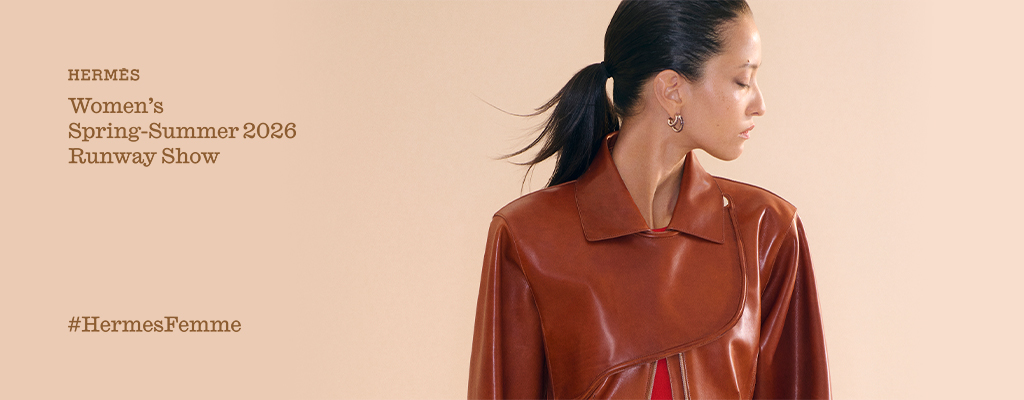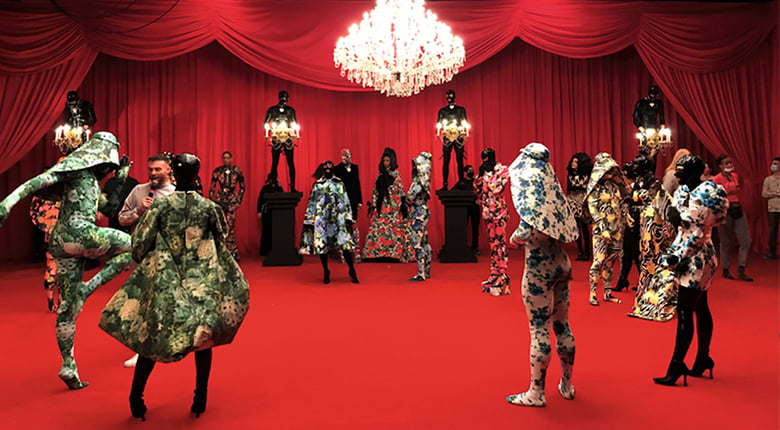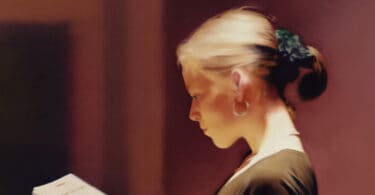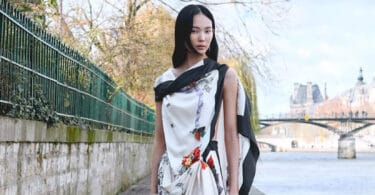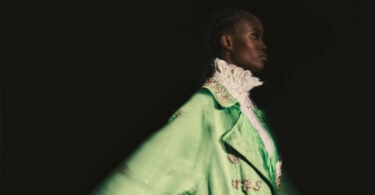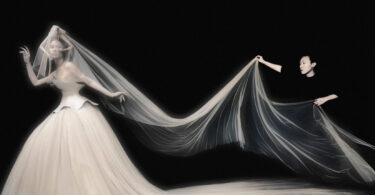
Right. So, Richard. What I really want to know is this: how come you think so big? It’s a few weeks since Richard Quinn astounded the fashion-verse with his eye-poppingly epic post-lockdown comeback. There we all were at the Electric Cinema on Portobello Road, safely socially spaced, not knowing what to expect at one of the first occasions the London fashion crowd had been able to gather since the pandemic. The last time Quinn had shown physically was at London Fashion Week on February 16, 2020 – and we all know the darkness that set in only a month after that. Then, suddenly, boom! Here it was: an all-dancing, flower-printed, psychedelically fetishistic Richard Quinn fantasy movie, joyfully exploding on the big screen with all the retina-vibrating impact of a major production.
Now I have him on a Zoom call to talk about it, I’m also wondering: in all the long days of a year’s isolation, didn’t he think it was mad to try and make his massive “ode to Hollywood Technicolor” happen with a huge cast of latex-clad catwomen, plus star appearances from Lily Cole, Lily McMenamy, Lila Moss, Bimini Bon Boulash and Tayce? “The main arc of it was to be like a line in the sand: to show this is what we’re about,” says Quinn. “This is the vision. And I wanted it to be a showcase of what we can do in London, even in a pandemic.”
Trademark baseball cap firmly on his head, the imperturbable Quinn is talking from his studio in an industrial unit under a railway arch in Peckham, south London. “It’s how I imagine a Richard Quinn world, and everyone in it,” he explains. “I wanted to see a girl tumbling through all these crazy, amazing dioramas. I wanted to have that cinematic narrative. Something that you can’t do on a catwalk, even with set-builds. I’m a huge fan of film. I didn’t want it to be quick cuts, like a flashing video shot on a phone. I wanted everything to have time to breathe, for it to be really escapist.”
Downstairs is Quinn’s printing works, where state-of-the-art digital machines purr out apparently limitless kilometres of whatever flowery signatures he wants, for extravagant dresses with matching backdrops to a flower-printed grand piano and even a set of printed London cabs. “Actually,” he chuckles, “The taxis are parked outside the studio.” His elder brother, James, had bought three cabs at a knockdown price from a dealer in Essex. After the film shoot, “We put the grand piano on eBay, and it sold immediately!”
Down-to-earth practicality, economy and nuts-and-bolts DIY resourcefulness are the foundation of everything Quinn does. From that comes a fearless ability to negotiate and navigate grand-looking things on a budget. The feature was shot on 16mm film at Wimbledon studios. “I feel like that added a layer to that expensive quality as well,” he says. Quinn co-directed and edited every sequence and angle. “The story, the narrative, the words and the set design were all done in-house. When people see the finish-point of our shows, they think they cost way more than they actually do. Whereas I’m always about, ‘How can I do this for the least money possible to make it look super-expensive?’”
Not so recklessly mad, after all.

Once Quinn had a deck for the project, all the performers – excited to get back to work – jumped on board, from the young dancers of the Dane Bates dance collective to the two acting-experienced Lilies and RuPaul’s Drag Race UK idols. “The minute people saw the scale of it, they were ready to go,” says Quinn. “There was a good energy on set. The dancers, who were graduates from all over the country, were suddenly all doing backflips and cracking whips. They went for it.”
Quinn says he’d spent a long time in lockdown rewatching all his favourite films and performances: Michelle Pfeiffer in Batman Returns, Pulp Fiction, Charlie and the Chocolate Factory, The Wizard of Oz. Those references became woven into his self-penned “scary story”. It kicks off with a Soho night-time scene tellingly grounded in his fascination for the forbidden worlds he first saw as a student. “When I started at Central St Martins, we were in the Charing Cross building. You’d work late at night and walk home through these amazing alleys. In the daytime everyone’s going about their business, but then suddenly you go down [at night] and it’s a completely different world. That really excited me.”
Hence the very British face-off between the extravagantly romantic taste for the English rose-strewn gown and subversive fetishwear that manifested in Quinn’s work from his MA graduation show in 2016. Still, it’s hard to compute just how far he’s been able to parlay that vision into a thriving business since then. The unprecedented early boost of being the first designer to have Her Majesty the Queen attend their show – in February 2018 – obviously helped at the start. As did being immediately taken up by Amal Clooney, Lady Gaga, Cardi B and many an event-going supermodel.
His AW21 movie extravaganza is well timed. Fashion is craving a comeback for glamour after all, and Quinn’s film is London fashion’s version of all the haute-couture drama that has since played

Whenever he’s pushed his design to delirious extremes, Quinn has always found that there are women who want it. Made-to-order gowns, often with lashings of rich pearl and sequin embroidery worked in India (“I went to visit them to make sure everything was OK, before Covid”) are a mainstay of his business. The tableau of bridalwear which formed the finale of his show has been a gift that keeps on giving ever since clients in the Middle East came across it. “There hasn’t been a month where someone hasn’t sent us a picture of one of those dresses, and asked, ‘Can I have something like this?’”But really, it’s the grounded practicality of Quinn that has enabled him to both survive and soar all along. “At the core, we really do make money, and that’s what I think success is,” he reflects. “You can have a facade, but it blows my mind when I hear of companies that are in huge debt. I would never take a loan. It’s just not in my nature; I feel like I had that drilled into me at a young age. The profit and loss is very much at the forefront of everything I do.”
Quinn was born in London in 1990, the youngest of five children by Irish Catholic parents who came to England in the ’60s. His father worked in the scaffolding trade and his mother trained as a nurse, later becoming a lecturer and child protection services mediator. The Quinns counted academic achievement highly but, says Richard, “I get all my business drive from my dad. I spent a lot of my childhood working with him, going in one of his lorries to west London and watching how he navigated business deals and negotiating with clients. Dad’s very upfront about money and explaining exactly why this cost this much. That’s really how I operate my business as well.”

That’s a formative experience nobody gets in fashion school, even as far as an MA at Central Saint Martins. It’s this worldliness that, soon after graduating as a winner of the H&M Design Award, gave Quinn the confidence to set up his own independent enterprise. Realising that he needed access to printing machinery, he set up an open studio which peers could also use at costs they could afford, and drove up and down the country in a lorry borrowed from his dad, buying up screen-printing equipment that fashion companies were scrapping. When things really got going, his sister Grace, a qualified physio, joined him under the rented Peckham railway arch a few doors along from his father’s scaffolding place.
Finally, with a true Quinn-family sense of enterprise and negotiating skills, he set out to talk to Epson about what he could do for them if they gave him one of their digital printers. “I reached out to them; it was a lot of emails,” says the designer. “Then, one day, this really nice lady called Mary emailed me back and said, ‘Oh, we can offer you a trade discount on one of our machines.’ And I said, ‘Let me come down, I’ll show you exactly what I’m about.’ So I went off to Hemel Hempstead. I think she was just starting off in marketing, and because she was quite young and a bit of a go-getter she got it.”
The relationship with Epson has flourished ever since. Having that machinery at his fingertips means being able to experiment fast, and control quality and production under his own roof. “We make it all in London; I think that’s a statement within itself,” Quinn observes. “I wouldn’t want to have it any other way. I think you should know your supply chains, put a face to your name.”

The film itself is Quinn’s biggest calling-card yet for the future he has his sights set on. In his mind, there’s a whole new way of enjoying the extravagance of a Richard Quinn world at home on the way. “The film shows we also can do interiors,” he says. “We’re looking to expand into wallpapers and bespoke furniture. In the future, I’d like to have a perfume, a Richard Quinn florist…”
It may sound mad and counterintuitive but, had the enforced pause of the past year not happened, Quinn might never have found the moment to make such an ambitious statement of intent. “It’s like a 360 of the brand, which, we just hadn’t had the time to think about before, or the capacity to do,” he concludes. “I think a film like this elevates us to the next level. That’s the most important thing right now: as well as the clothes, it’s having that real, strong statement where we can start to explore all these different avenues.”
Photography by Karolina Krasuska / Everynight Images. Taken from Issue 67 of 10 Magazine – BOLD & BEAUTIFUL – order your copy here.



